March 17, 2017
Air Date: March 17, 2017
FULL SHOW
SEGMENTS
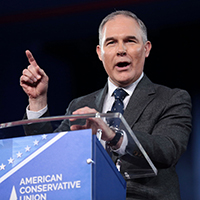
Environmental Protection on the Chopping Block
View the page for this story
Gina McCarthy, former administrator of the US Environmental Protection Agency , says deep budget cuts and staff reductions would damage the agency’s mission to protect the public with sound science, and most harm communities that need the greatest environmental protection. McCarthy tells host Steve Curwood why she believes EPA’s Obama-era climate regulations are on firm legal footing, and why dozens of programs slated for gutting or total elimination by the Trump Administration are essential to ensure clean air and water for all Americans. They discuss fuel economy standards, the future of the Paris Climate Agreement and why environmental justice is a vital EPA program that protects the most vulnerable communities. (18:00)
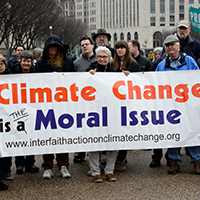
Inoculating the Mind from Climate Misinformation
/ Helen PalmerView the page for this story
Concerns about so-called ‘fake news’ have never been higher. Google searches for the term have quintupled since the November 2016 election, and these days it’s hard to be sure what information out there is true. According to Climate Communications scientist Anthony Leiserowitz, on the issue of climate change, there’s a lot to be skeptical about. Living on Earth’s Helen Palmer speaks with Leiserowitz about how a new study of his can help protect the public from buying into false climate information. (08:50)

BirdNote: Swallows of Capistrano
/ Mary McCannView the page for this story
Every spring, Cliff Swallows returned to Capistrano in Southern California, delighting locals and visitors alike. Then, as Mary McCann explains, renovation work drove them from their historic nest-sites, but now there’s hope they’ll come back. (02:00)
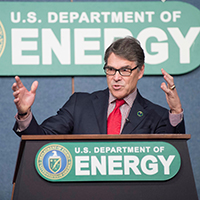
Gov. Perry Takes Over the Energy Dept
View the page for this story
Former presidential hopeful and Texas Governor Rick Perry now heads the Department of Energy, which he once said should be abolished. Host Steve Curwood spoke with Kevin Knobloch, former Energy Secretary Ernest Moniz’s Chief of Staff for an insight into the challenges of the job. They include managing the country’s nuclear waste and nuclear arsenal to meet such threats as Iran and an aggressive North Korea, a robust research program that the President’s budget proposes to defund, and energy efficiency. (09:45)

Lessons From Mexico About the Deepwater Horizon Disaster
/ David LevinView the page for this story
In 1979, the Ixtoc oil well blew out off the coast of Mexico – and an oil slick spread in the Gulf over the next nine months. When the Deepwater Horizon blowout happened in 2010, with its ensuing millions of gallons of oil released, scientists noted striking similarities to the Ixtoc spill. And now -- as David Levin Reports -- ocean floor expeditions near the Ixtoc site seek to find out how the ocean is recovering three decades out, hoping to shed light on the future of Deepwater Horizon. (08:15)
Show Credits and Funders
Show Transcript
HOST: Steve Curwood
GUESTS: Gina McCarthy, Anthony Leiserowitz, Kevin Knobloch
REPORTERS: David Levin, Mary McCann
CURWOOD: I'm Steve Curwood. The Environmental Protection Agency is squarely in the crosshairs of an administration focused on budget cuts, but the agency's outgoing administrator says that won't benefit the American people.
MCCARTHY: Do they really think that the environment is okey-dokey now? That we're finished? We can put a check mark on that and just sort of cruise for the next four years? It's discouraging that EPA, as a science and public health agency, isn't being given the respect it is due as a bipartisan opportunity to protect some of our core values like clean air, clean water, and a safe and stable planet.
CURWOOD: A conversation with Gina McCarthy about her concerns for the future of the EPA. Also, the swallows who always return to Capistrano. That and more, this week on Living on Earth. Stick around.
[NEWSBREAK MUSIC: Boards Of Canada “Zoetrope” from “In A Beautiful Place Out In The Country” (Warp Records 2000)]
[THEME]
Environmental Protection on the Chopping Block
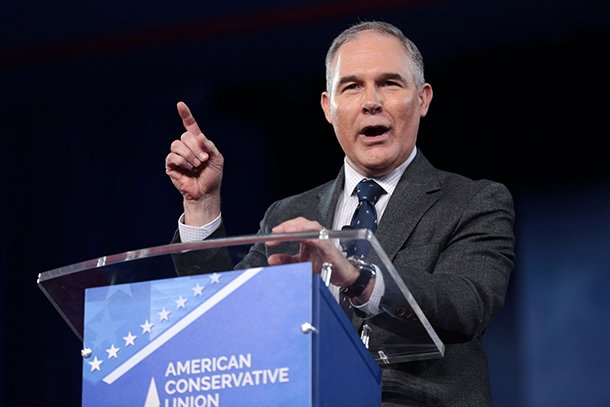
EPA Administrator Scott Pruitt recently said he does not believe carbon dioxide is a primary driver of global warming, contradicting the EPA’s own website. (Photo: Gage Skidmore, Flickr CC BY-SA 2.0)
CURWOOD: From PRI, and the Jennifer and Ted Stanley Studios at the University of Massachusetts Boston, this is Living on Earth. I’m Steve Curwood. The US Environmental Protection Agency that shaped the Clean Power Plan and vehicle efficiency standards to address climate change for the Obama Administration is now being led by a declared climate skeptic. Incoming EPA Administrator Scott Pruitt recently stated that he does not believe carbon dioxide is a primary contributor to climate change. Gina McCarthy preceded Mr. Pruitt as EPA Administrator and was a major architect of the Obama air pollution rules, and she joins me now.
Gina, welcome back to Living on Earth.
MCCARTHY: Thank you. It's great be back again.
CURWOOD: So, let's cut right to the chase. Your successor Scott Pruitt is a protégé of Senator James Inhofe from Oklahoma, who famously went out on the Senate floor with a snowball saying there is no such thing as global warming. In fact, Administrator Pruitt has also said recently that it's very doubtful that carbon dioxide contributes to climate change. How do you feel about that in light of science and present politics?
MCCARTHY: Well, I think as a person who ran the Environmental Protection Agency and understands it as a science agency, we do public health protections based on science. It's a little disconcerting to have people question what is perhaps one of the most robust records that we have available to us about what's happening in the world today, especially given the tremendous consequences of our changing climate.
CURWOOD: So, the Trump administration is talking about slashing the EPA budget. You hear different numbers, 20 percent, 30 percent. How could they do that and what programs you think would suffer as a result?
MCCARTHY: Well, we saw the fact that the pass back that was prepared by the president looked at not only making overwhelming cuts, but significant cuts to the scientists in the agency. We're talking about potentially 42 percent fewer scientists at EPA. And that's going to hinder everything we do. That is our sort of framing for what Congress told us to do, not to shoot from the hip but to make really sound public health decisions based on science. We also saw that 38 programs were slashed in their entirety, and it's also focused on eliminating voluntary programs like EnergyStar.
So, if this administration doesn't want to support the science that underpins our rules then, you're undermining the authority and responsibility that Congress gave to that agency, and if we can't even work with businesses on a voluntary basis, do they really think that the environment is okey-dokey know, that we're finished, we can put a checkmark on that and just sort of cruise for the rest of the next four years? It's discouraging that EPA as a science and public health agency isn't being given the respect that it is due as a bipartisan opportunity to protect some of our core values like clean air, clean water and a safe and stable planet. That's why people created EPA. That's why we've been working for 47 years for the American people and our kids. I don't know why we would want to think that our job is done. It is far from it.
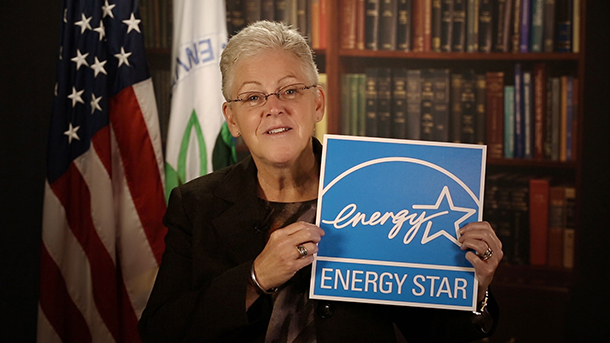
Above, former EPA Administrator Gina McCarthy holds up the Energy Star logo. Energy Star, created in the last year of President George H.W. Bush’s term, is one of more than fifty EPA programs that President Trump’s budget outline proposes to eliminate entirely. (Photo: EPA, public domain)
CURWOOD: In terms of the programs that we might lose from the EPA with these projected cuts - you mention the EnergyStar program – but what are some of the others?
MCCARTHY: Well, one other program would be our brownfields program, and that's a program that's actually essential for environmental justice communities because this program that looks at contaminated properties, tries to provide information to the states and local communities to assess the contamination, figure out how to get it back on the economic rolls again so that they can be invested in, and the jobs can come back.
We are looking at specific research programs as well, significant reduction in our climate affects whether they're voluntary or whether it's about looking at the science that underpins those efforts. It's taking away our ability to fund research in universities that are essential to underpinning our health-based standards setting process.
You know, one of them that baffled me was we have a program that looks at endocrine disruptors, basically chemicals that can significantly impact human beings. Apparently that wasn't worth continuing as well. So, there are some fundamental decisions that are being made by this administration through a budget process that I actually think are worth public input and it's a shame that they're doing it through the budget instead of a direct discussion with the public.
CURWOOD: I recall that Ann Gorsuch came into the EPA appointed by President Reagan. She said she was going to cut 25 percent, and she was gone within two years, and some of her associates had some legal problems. It feels a little bit like déjà vu.
MCCARTHY: Well, you know, we've had a lot of Republican administrations that have come in. I know that that particular administration wasn't very successful, but I've never seen one quite like this that moves so quickly. Most of the people going in there don't really know the agency. They come in with sort of an objective to really take down our ability to do science well. I just don't know who that benefits and I know there's been a lot of rhetoric during the Trump campaign about EPA and somehow working contrary to the economic interests of this country. I just would like to see where that data is coming from because in my world, growing up in the ’60s, I breathe a lot easier, I know where my drinking water comes from. I understand that my best interest and my family's best interest is being provided for as best we can. Well, at the same time, I know that we are one of the strongest economies in the world. Our GDP has tripled while we have reduced air pollution 70 percent. Where is the damage? Where is the conflict?
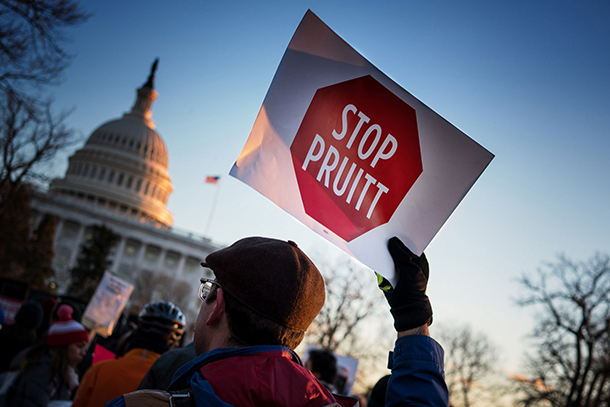
Concerned about Scott Pruitt’s potential conflicts of interest as nominee for Environmental Protection Agency Administrator, activists called on tthe Senate to reject Mr. Pruitt in the weeks before his confirmation. (Photo: Lorie Shaull, Flickr CC BY-SA 2.0)
Right now, the fastest growing sector in our economy is the solar industry. That's where the jobs are. Right on the heels of that, wind is really beginning to get so inexpensive that it's competing similar to solar against fossil energy. These are the technologies of the future and the jobs of the future. I hate the idea that we are going to deny what is a robust science record, and we're also going to be sending a signal to our children that maybe that's not the place to go for a job.
CURWOOD: So, goodbye, American leadership. Hello, Germany and China.
MCCARTHY: Well, China has made that very clear. [LAUGHS] You know, at Davos, at the world economic forum, when people started bemoaning the fact that the US government appeared to be backtracking on things like climate and the investments that we would need for the future, China put up their hands and with that they put billions of dollars up for renewables and they took their hand down when it came to building significantly more coal units to generate electricity there. So, they sent an immediate signal that if there is a void and the US doesn't want to play, they are more than willing to fill that void and get those advantages.
CURWOOD: So, let's talk regulation. President Trump is directing to Mr. Pruitt to revise or rescind the Clean Power Plan that was finally promulgated in 2015. Now, considering that the EPA is required by law and Supreme Court decision to regulate greenhouse gas emissions, how likely is it that the Trump administration can walk back the Clean Power Plan?
MCCARTHY: Well, I have to wait and see what his executive order says, but I think he's made it clear that he’s interested in pulling back in the Clean Power Plan. And let me make one point very clear. His only vehicle to address the Clean Power Plan is an executive order telling the agency to take specific actions, but there is no way in which an executive order can trump a rule. It has to be done through a rulemaking process that requires significant public input. It requires an evidentiary record, a record of the science, a record of the facts. We have developed a great record of science and data to support the Clean Power Plan and our other rules.
We have actually won in the very vast majority of cases when those rules have been tested. Let me tell you, 90 percent over the last three years in which we have taken action under the Clean Air Act on climate, we have won in its entirety, and the ones that we have lost up are narrow things that we needed to take care of. So I am confident that we have done it in accordance with the law and with science. If this administration wants to pull back on that, they're going have to figure out how to say, “Whoops, I made a mistake, I'm going have to redo this,” and expect that that redo is going to take the place of a well done, extremely engaging, extremely well thought out outreach program that went with it, so the public could speak. That's going to take a long time, especially if 20 percent of the people have already been shown the door. But the first thing they are going to do is figure out whether or not they can get it out of the hands of the court in the first place.
CURWOOD: And what does that mean?
MCCARTHY: Well, the D.C. Circuit could decide, “I don't want to give it back to the agencies to rethink”. They could say that this is a big rule. “We're ready to issue a decision on it to decide.” Then they're going to have to go back and ask the Supreme Court to do that. The Supreme Court has spoken on climate issues and carbon pollution three times. They have been very clear. They have used words like “robust” for the science in their decisions. So, they kind of know that this is a big deal, and they've sent a signal that they want to rule on it.
CURWOOD: And, as I understand it, many many states have prepared to move forward with the lean Power Plan, that really it’s on its way.
MCCARTHY: Well, the vast majority of states who have sued the EPA are already meeting the targets that we set for 2022, claiming that it was just overwhelmingly difficult and states couldn't do it and it was unreasonable. There is nothing in facts today that indicate that the Clean Power Plan was anything but reasonable and appropriate following the way the clean energy transition is already happening.

President Trump’s proposed budget outline has a 31% cut for the EPA. (Photo: Official White House Photo)
[MUSIC: The Nile Project, “Mulungi Munange” on Jinja, Micheal Baxibu/Steven Sogo, Zambaleta Music ]
CURWOOD: My guest is Gina McCarthy, who just finished her term as Administrator of the EPA. More of our conversation is just ahead. So stay tuned to Living on Earth.
ANNOUNCER: Support for Living on Earth comes from the Gordon and Betty Moore Foundation, and from a friend of Sailors for the Sea, working with boaters to restore ocean health.
[CUTAWAY MUSIC:The Nile Project, “Tenseo” on Jinja, Jorga Mesfin/Mohamed Abozekry/Mamdouh Fawzi, Zambaleta Music]
CURWOOD: It’s Living on Earth, I’m Steve Curwood. We’re back now with former EPA administrator Gina McCarthy. So we're talking on March 15th, and it's the same day that President Trump is in Detroit speaking to automakers who are asking to roll back the automobile efficiency rules that were promulgated during your time at the Environment Protection Agency. Gina, what are your concerns?
MCCARTHY: Well, I understand there's going to be a new executive order, so I'll have to see what that says, but, you know, we worked with the automakers - all of them, the big three and in the US and internationally. We worked with the environmental constituents. We worked with California to actually lay out these rules and these specific standards. EPA and the Department of Transportation actually did a rule together to align one national program to manage our relationship with automakers. And so, everybody was involved with this all along, and so it disappoints me if the manufacturers right now are looking to revisit that standard. Frankly, that's going to provide a level of uncertainty for them that we tried to get out of the picture because when you're an automaker, you're projecting what the consumers will want and what the government will require over the course of 10 or 11 years ahead. So, it provides a measure of uncertainty for them which I don't frankly think will be welcome.
CURWOOD: Now, what if the Trump administration goes after what's known as “the endangerment finding.” That is, after Massachusetts sued the EPA, the Supreme Court agreed that carbon dioxide should be considered as a pollutant. Your agency, in fact, the EPA did make the determination that carbon dioxide is a pollutant, and that's the basis of these rules. How likely is it that the EPA could actually roll back the endangerment finding?
MCCARTHY: Well, you know, if they go after the endangerment finding, they're going to take years, and they are simply not going to undo that endangerment finding. It wasn't just looked at initially by the Supreme Court to say, you know, if carbon pollution is a problem, EPA's going to have to consider it under the Clean Air Act as a pollutant and do something about it. We actually had a huge determination that we made an endangerment finding with the light-duty vehicle rule early on in the administration, and that endangerment finding was looked at all the way to the Supreme Court. They did not overturn that, and every time we've done a rule related to carbon pollution, we have redone and advanced the discussion of the science on the endangerment finding, and there is more evidence, the farther along we are that the climate is changing and carbon pollution that we generate is the basis for a lot of that change and that it is a danger. So the record’s only gotten stronger. It is one of the most solid decisions that that agency has ever made, so if they want to spend their time looking at the endangerment finding, maybe it'll keep them out of trouble elsewhere.
CURWOOD: Let me ask you about something else. Secretary of State Rex Tillerson has said it would be a good idea for the U.S. to stay in the Paris Climate Agreement. I'm not sure he has a lot of support inside the adminstration for that, but he said that. How would the US be able to uphold what it's promised at the Paris Agreement if the Clean Power Plan goes away, if automobile efficiency standards are made more lax?
MCCARTHY: Well, I think the US over the past decade or so, we have shown a tremendous commitment to address climate change, and as a result, you know, for a developed country our CO2 emissions have gone down, relatively speaking, more than any other developed country. And so I do think that other countries recognize that the politics have changed in this country, and they talked about that in Morocco and they talked about it in Davos and other places, and they've understood that the US may not make a lot of progress over the next few years.
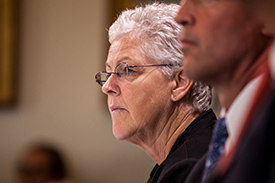
Former EPA Administrator Gina McCarthy worked at the agency for all eight years of Obama’s two terms, serving as Administrator during the last four. (Photo: Chesapeake Bay Program, Flickr CC BY-NC 2.0)
Paris was a breakthrough in so many different ways. It was a breakthrough to have every country recognize that they can put something on the table moving forward. It was a breakthrough to get better accountability mechanisms, to share information, to enable developing countries to understand new technology choices that are available to them. It would be discouraging if what the US did was not only go on the sidelines, but send a signal to those developing countries that one of the two biggest polluters in the world have decided to take a little bit of a break.
CURWOOD: So, I noticed that Mustafa Ali who's been running the environmental justice program at EPA has resigned. How important is the EPA's environmental justice office? What will America lose buy him leaving and eliminating that office?
MCCARTHY: I think what we have recognized is that, while we've made tremendous improvement nationally, there are a number of communities that have been left behind. There is a disinvestment now in infrastructure that is startling, and I think I don't need to say a whole lot more than Flint, Michigan, to remind people that there are people living in poverty that right now don't have access to clean water, and when someone says that to me, I think I'm not in the United States of America anymore, but I'm in a developing world that’s struggling. Well, we're not struggling. This country is wealthy compared to others. We should not leave people behind, so when you see someone like Mustafa Ali who has been with the agency for decades, that was my environmental justice adviser, who didn't go into communities and say, "I’m going to tell you what to do.” He went into communities and said, "What do you need to move forward. How do we help bring economic vitality through here by cleaning up sites that are now contaminated, that make them ready for jobs and economic growth?" When we have a person like that decide that he can't make progress moving forward, then it's disturbing to me, and I am tremendously disappointed that that is one of the offices and one of the efforts that this administration is apparently divesting itself off.
CURWOOD: Gina, you gave eight years of your life to the federal government serving at the Environmental Protection Agency, the last four at the very top. I imagine it’s really devastating for you to see what's going on there, and what do you hear from your former colleagues about morale?
MCCARTHY: Well, I'm trying not to have conversations with them, and they are certainly not calling me because in the current atmospheric, it wouldn't be healthy for them at this point. But, I know these people. There are 15,000 incredibly talented people who are so dedicated to their public health mission and their interest in protecting the environment and most of them have lived through changes in administrations and understand that policies change. I think the difficulty here is that it's not just a swing in policy, but there's a really serious question as to whether or not this administration actually cares about the mission of this agency. So I can only imagine that they must be tremendously concerned about that.
CURWOOD: Gina McCarthy is the former Administrator of the United States Environmental Protection Agency and now a fellow at the Harvard T.H. Chan school of Public Health and the Kennedy School's Institute of Politics. Administrator McCarthy, thanks so much for taking the time with us today.
MCCARTHY: It was great, and thanks for letting me speak to these issues. They are important, and I appreciate you taking an interest in them.
Related links:
- The Washington Post: “Trump’s budget takes a sledgehammer to the EPA”
- The Guardian: “EPA head Scott Pruitt denies that carbon dioxide causes global warming”
- Reuters: “Trump seeks input from U.S. energy companies on Paris climate pact”
- The Hill: “Trump appointee steps down at EPA”
- About EPA Administrator Scott Pruitt
- About former EPA Administrator Gina McCarthy
[MUSIC: Mischa Maisky, Prelude to Cello Suite No.2, on Bach: The Cello Suites, J.S. Bach, Deutsche Grammophon]
Inoculating the Mind from Climate Misinformation
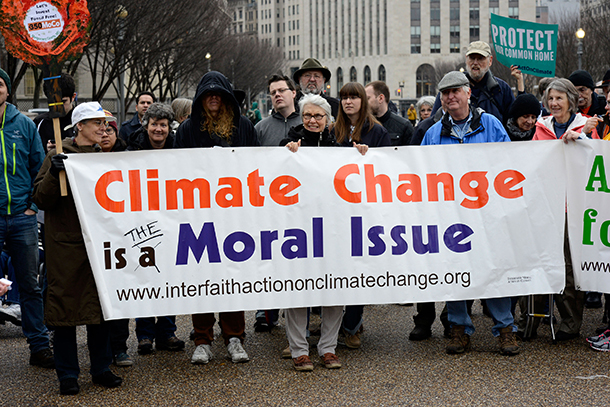
An interfaith contingent of the Global Climate March protests in Washington D.C. in 2015. According to Leiserowitz, people are most convinced of the reality of climate change when the message comes from a trusted source, like a religious organization. (Photo: Steven Melkisethian, Flickr CC BY-NC-ND 2.0)
CURWOOD: Now, what you call “news” and what you condemn as "fake news" can depend on where you stand. The new president tweeted accusations of fake reporting more than ten times just in January, and Google searches for the term have increased a thousand-fold since October 2016. The divide in opinion on what's real and what isn't is among the starkest on hot-button issues, including climate change. Now a study in the journal Global Challenges suggests that attitudes on these issues are not immutable, even among the skeptical, and presentation of accurate information can sway opinion. Study co-author Anthony Leiserowitz is director of the Yale University Program on Climate Change Communications. Living on Earth’s Helen Palmer asked him about climate disinformation and the study.
PALMER: So, Tony Leiserowitz, why do you think it's necessary to try to inoculate the public against climate disinformation?
LEISEROWITZ: Yeah, well we've seen for many, many years that, in fact, there's been a very concerted disinformation campaign going on to try to undermine and discredit the scientific consensus on climate change. In our last national survey, we found that only 15 percent of Americans understand that it's more than 90 percent of climate scientists who are convinced that human-caused global warming is happening. There's plenty of uncertainty out there about how bad will droughts be by the year 2075 and how is precipitation going to change around the world. But about the fundamentals that this is real? There is really almost no dispute whatsoever. So we know that that's a very real misperception.
PALMER: Now you are obviously the director of the Yale University program on climate change communications, so you have actually done an experiment to try and work out if there is some way to counter this kind of disinformation. Tell me about the experiment you did.
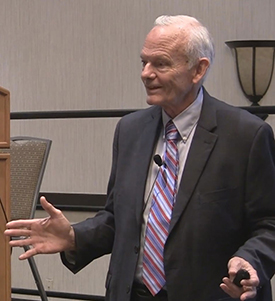
Arthur B. Robinson is a biochemist and former Republican candidate for the US House of Representatives. He runs the Oregon Institute for Science and Medicine, an organization that disputes the reality of human-caused climate change and distributed a document rejecting climate change legislation called the Oregon Petition. The petition listed over 30,000 names. (Photo: Jersnav, Wikimedia Commons CC BY-SA 4.0)
LEISEROWITZ: Sure. So, this was building on a larger body of research that we and other colleagues around the country have been doing for some years, and that is looking at what happens when you actually inform people about the scientific consensus, and what we've consistently shown is that the average American will change their own estimate of that consensus by about 20 percentage points when they're simply told that 97 percent of climate scientists are convinced that human caused global warming is happening. But what we also know is that this is not an uncontested terrain, that we don't simply get to tell people that there is a scientific consensus because there are other people and organizations out there who continue to try to question it.
So, that was the backdrop for this study where we wanted to see, so what happens when you expose people not just to the scientific consensus message, but to one of the most powerful counter messages that are out there, and then, more specifically, is it possible to inoculate people against the effect of that disinformation? And basically, it's a concept very similar to what we know of for the human body. We know when you go get your flu shot, we know that if you expose the human immune system to a limited, weakened version to the flu virus, the body learns how to recognize and to protect the body against that virus when it finally does encounter it back out in the wild. In a similar, analogous way, what we are looking at in this study is what happens when you expose people to a shortened weaker version and an explanation of why that disinformation exists, where it's coming from, and what's wrong about it. Does that protect people from the negative effects of the disinformation?
PALMER: So, what did you actually do?
LEISEROWITZ: So, we did a very large national study where we divided people essentially to six different groups. First, was the control group. So, just kind of held aside to see what happens when they don't get anything. A second group was given the consensus message and again, like we've seen in all the prior studies, their opinions changed by about 20 percentage points. A third group was exposed to one of the leading disinformation ideas, which this is "Oregon Petition". This was conducted by the Oregon Institute of Science and Medicine, which sounds impressive but is actually just a ragtag organization in Southern Oregon. They got 31,000 people to sign a petition saying that they don't believe that global warming is happening, and they claim that these people were all scientists.
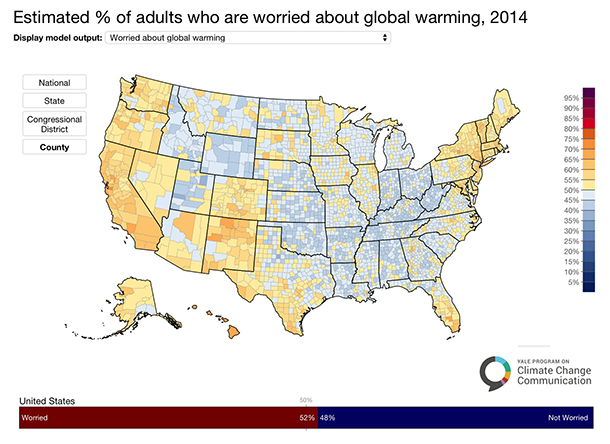
While the majority of Americans are worried about climate change, most occupy neither end of the climate concern spectrum. (Photo: Yale Program on Climate Change Communication)
Well, unfortunately when you look at who actually signed it, it included noted Nobel Laureate such as Ginger Spice of the Spice Girls, I think Adolf Hitler signed it, Mickey Mouse signed it and then, further, the people who legitimately cited almost none of them actually have a background in atmospheric or climate science, but that doesn't matter because from a communications standpoint those who've been opposed to climate action have used this exact argument over and over and over again for years. Because if you're a normal, regular person who just doesn't know very much about it, and you are told 31,000 scientists have signed a petition saying that human-caused global warming is not real, most people will go, “Gosh, that sure doesn't sound like scientific consensus.”
So, what did we find? Is that when you simply expose people to that argument, people's estimate of the consensus actually drops, just like you would expect, by about nine percentage points.
Then, in the third condition, we actually put the two messages side by side. When exposed to the fact that this consensus but also exposed to the disinformation, essentially they canceled each other out. And then came the last two conditions that were really the heart of this study. The first provided a short inoculation. People were shown the consensus message, the true message, and then told that ,while there is this consensus, there are some politically motivated groups that use misleading tactics to try to convince the public there's a lot of disagreement, and then they were exposed to the disinformation. And what we found is that about a third of the original treatment effect. People would move in a positive direction towards understanding the consensus.
The last group was then shown a longer innoculation, and that was able to protect about two-thirds of the beneficial effect of being exposed to the truth. So, it is possible to essentially inoculate the mind against disinformation which certainly has major implications for the larger issue we're all wrestling with around fake news.
PALMER: Now, big problem therefore is that these days people are getting their news from particular silos that the people who believe that indeed it's all a hoax and all a scam, they are listening to the kind of news that you are not likely to be broadcast on. So, how do you get over this problem that basically you'll be preaching to the choir?
LEISEROWITZ: Yeah, so this is really important and tough in today's world because we are increasingly fragmenting into ever finer-grained media sources, and some of them are echo chambers where they have been constructed in a way to not trust any information that comes from outside the "trusted source”. But it's also important to recognize that most people are actually not in the choir. Then comes the congregation, most of them are not actually paying that close of attention to climate change, and then there's all the people who are not in the church at all. In fact, when you break down the American public, you see that over 70 percent of Americans are in groups that we would say are neither of what we call “the alarmed”, which is fully convinced this is real and very serious or in “the dismissive”, who think this is a hoax.
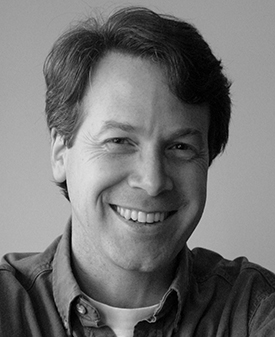
Anthony Leiserowitz is Senior Research Scientist and Director of the Yale Program on Climate Change Communication at Yale University. (Photo: Anthony Leiserowitz)
PALMER: So, how do you reach them, the mostly disengaged?
LEISEROWITZ: Yeah, so each one of these groups is different. You need to reach them through sources that they trust and in language and in concepts that matter to them. We know that, for example, many, many Americans think that climate change, if it's real, is distant. Distant in time, meaning the impacts won't be felt for a generation or more, or distant in space. This is about polar bears or maybe some developing countries but not the United States, not my state, not my city, or any of the people and places I care about. That's just fundamentally also a big misunderstanding is that, in fact, climate change is here and now. The impacts can be seen and felt all over the country as we speak here today, and likewise, many people don't recognize that the solutions to climate change are also here and now. So, bringing it down literally to earth and recognizing that this is something in the here and now, really helps to engage those other groups that say, hey, this is far away in time and space.
PALMER: Now, obviously we're in the earliest days of a new administration, but given your own research, are you optimistic about the possibility of reaching people and the possibility of these kinds of messages getting across?
LEISEROWITZ: Not particularly. Already we’re seeing a number of things that appear to be frankly at odds with the truth. As Americans increasing fragment into these kinds of echo chambers, that makes it incredibly hard to have rational conversations about how we move forward because now we're operating with completely different sets of "facts".
CURWOOD: Anthony Leiserowitz directs the Yale University Program on Climate Change Communications. He discussed his study “How to Inoculate the Public Against Misinformation on Climate Change” with Living on Earth’s Helen Palmer.
Related links:
- The study: “Inoculating the Public against Misinformation about Climate Change”
- Yale Program on Climate Change Communication
- Google Trends: “fake news”
[MUX - BIRDNOTE® THEME]
BirdNote: Swallows of Capistrano
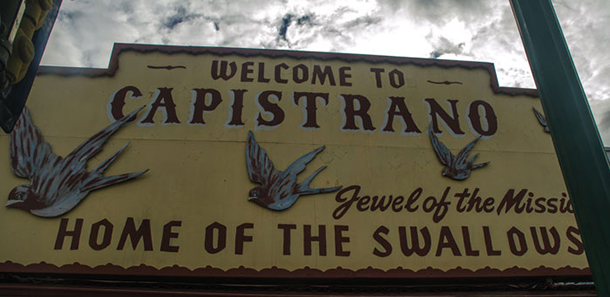
The swallows nested in the Capistrano Mission walls until the 1990s. (Photo: Wayne Hsieh)
CURWOOD: Plenty of Americans, and not only those with Irish heritage, made sure to “wear the green” on March 17 in honor of St Patrick. But there’s another saint who celebrates his special day just two days later, and as Mary McCann explains in today’s BirdNote, he has special significance for swallows and a captivating spot in southern California.
http://birdnote.org/show/swallows-capistrano
BirdNote®
The Swallows of Capistrano
MCCANN: Every year, the change from winter to spring brings millions of Cliff Swallows northward from Argentina to North America.
[Cliff Swallow vocalizations: http://macaulaylibrary.org/audio/111063]

One swallow in flight. (Photo: Bryce Bradford)
Some swallows, those that nested in the Mission of San Juan Capistrano, about halfway between Los Angeles and San Diego, were destined for fame.
Since the early 1800s, the swallows had returned, year after year, to the same mud nests built high on the stone cathedral walls of the mission.
[Cliff Swallow vocalizations: http://macaulaylibrary.org/audio/111063]
The swallows arrived on or about March 19th, St. Joseph’s Day. So regular was the cycle that, over many years, the Catholic feast of St. Joseph’s Day and the return of the birds became intertwined and were celebrated together.
When a catchy song hit the radio airwaves in 1940, nearly everybody came to know the swallows of Capistrano.
[https://www.youtube.com/watch?v=VUSC37bLuuU]
But today, Cliff Swallows no longer nest at the mission. During a restoration project in the 1990s, the venerable mud nests were removed from the mission walls. Since then the birds have opted to reside elsewhere in town.
Now, though, a concerted effort is under way to attract the beloved swallows back to the mission, an effort that includes putting up man-made nests.
[MUSIC: “When the Swallows Come Back To Capistrano.”]
As to whether the swallows will ever really return, though, only time will tell.
I’m Mary McCann.
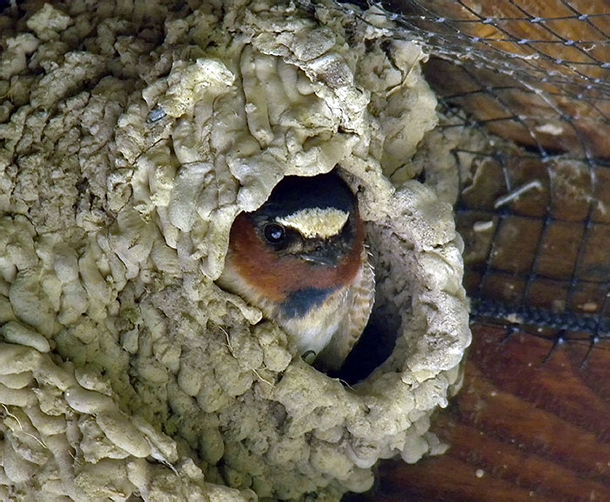
A swallow nests. (Photo: Mike Hamilton)
###
Written by Bob Sundstrom
Bird sounds provided by The Macaulay Library of Natural Sounds at the Cornell Lab of Ornithology, Ithaca, New York. 111063 Recorded by Thomas G. Sander.
BirdNote’s theme music was composed and played by Nancy Rumbel and John Kessler.
Producer: John Kessler
Executive Producer: Sallie Bodie
© 2017 Tune In to Nature.org March 2017 Narrator: Mary McCann
CURWOOD: And soar on over to our website LOE.org for some photos.
Related links:
- Listen on the BirdNote website
- Efforts to attract the swallows to the mission
[MUSIC: “When the Swallows Come Back To Capistrano.”]
Coming up...how former Texas Governor Rick Perry might set priorities at the U.S .Department of Energy. That’s just ahead here on Living on Earth. Stay tuned.
ANNOUNCER: Funding for Living on Earth comes from you our listeners, and United Technologies - combining passion for science engineering to create solutions designed for sustainability in the aerospace, food refrigeration and building industries. UTC companies such as Otis, Carrier, Pratt & Whitney and UTC Aerospace Systems are helping to move the world forward. This is PRI, Public Radio International.
[CUTAWAY MUSIC: The Nashville Mandolin Ensemble, “Music For a Found Harmonium” on Plectrasonics]
Gov. Perry Takes Over the Energy Dept

Rick Perry was sworn in as the Department of Energy Secretary on March 2nd. (Photo: ENERGY.GOV, Flickr U.S. Government Work)
CURWOOD: It’s Living on Earth, I’m Steve Curwood.
Former Texas Governor Rick Perry is the new US Energy Secretary. It’s an ironic choice, as during his Presidential bid, Rick Perry dubbed the Energy Department as one that could easily be abolished with no loss, and some observers have suggested Governor Perry didn’t actually understand the job when it was offered to him. Yet, as governor, Rick Perry watched over a massive increase in wind power in the Lone Star State and supported the extensive oil infrastructure.
Kevin Knobloch was the Chief of Staff for Perry’s predecessor at Energy, Ernest Moniz, and he joins us now. Kevin, welcome to Living on Earth.
KNOBLOCH: Thank you, Steve. I'm delighted to be with you.
CURWOOD: So, there seems to be some confusion about the Department of Energy in the mind of the public. What exactly does the Department do?
KNOBLOCH: The Department of Energy has an extensive mission scope that isn't always well understood. First and foremost, DOE is responsible for our nuclear weapons arsenal, building them, maintaining them, dismantling them when a treaty like the new START treaty with the Russians comes into force. The department also is responsible for 17 national laboratories which represent probably the single, largest, annual investment in basic science R & D, research and development in the physical sciences in the world, certainly in the country.
There's parts of DOE like ARPA-E designed after DARPA in the Defense Department to support emerging technologies in the commercial space and help them get to commercialization. A loan program, which has a $30 billion dollar loan portfolio, supporting advanced clean energy technology. And then the last big piece is the clean up program of the legacy waste from the Cold War weapons program, often radioactive waste, toxic waste, sometimes mixed, and that's a $6 million a year annual investment to fulfill our commitment to the communities that hosted these facilities during the Cold War.
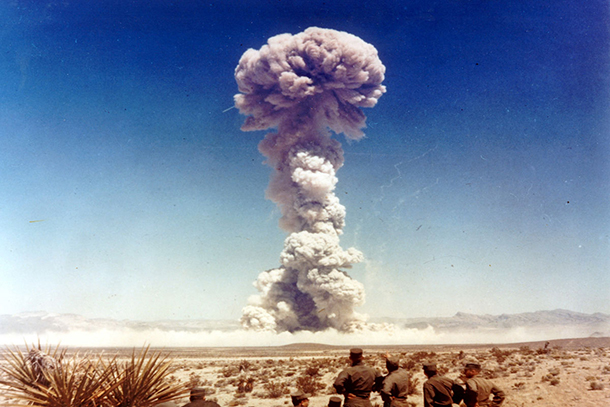
Military personnel observe a nuclear weapons test in Nevada in 1951, park of a federal weapons testing program that’s been in progress for decades. (Photo: International Campaign to Abolish Nuclear Weapons, Flickr CC BY-NC 2.0)
CURWOOD: Looking heading now to the present administration, in the Obama administration, the first Energy Secretary had a Nobel Prize, Steven Chu, the physicist from California. The outgoing secretary, Ernest Moniz, nuclear physicist at MIT. One of the criticisms of Rick Perry, the former governor of Texas, is that, well, his scientific background is a bit thin. How important is a strong academic foundation in science for the job of running the Energy Department?
KNOBLOCH: I would suggest that it's not essential that you be a scientist to be the Energy Secretary and of course over time, a number were not. What is essential is that, I believe, that you have experienced, highly regarded scientists in some of the key roles. So, in our term, the second Obama term when Secretary Moniz headed the department, Lynn Orr, subsurface expert scientist, was the Under Secretary for Science and Energy. Esteemed scientist Cherry Murray was head of the Office of Science and so on. So, if the Energy Secretary is himself or herself not a scientist, it's very critical that capable scientists and technologists are put in those other roles.
CURWOOD: What did you notice in his record as Governor of Texas that you think will help him on the job at the Department of Energy?
KNOBLOCH: Texas, of course, is one of our largest oil and gas producing states and oil, and gas remains a part of our energy economy. So, he clearly is knowledgeable about that slice of the energy economy. During his multiple terms as Governor of Texas, Texas built a lot of wind, a lot of wind power. It is now the state with the largest installed wind capacity in the country, and that was on his watch, so I suspect he has a strong appreciation of the fact that wind power not only has he added a zero carbon energy source to his state and the national energy mix, but it's producing a lot of jobs and these projects, these wind projects, are adding tax income for communities. They're adding leasing income for ranches and farmers that host them.
I would add one more point that in the Department of Energy nuclear weapons production complex, a very key facility is the Pantex plant in the Texas Panhandle which is where we do assemble and maintain and disassemble nuclear weapons. That's a very major employer in Texas and very central to our ability to maintain the nuclear deterrent and be responsive, as I said, to nuclear treaties.
CURWOOD: Here at home is great concern about nuclear power, what role it should play going ahead. Your views about how far things have come and then where they need to go?
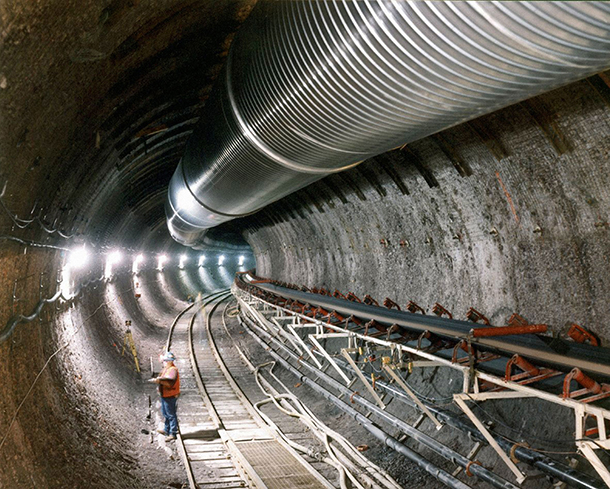
Yucca Mountain Facility was built by the Department of Energy to determine whether the location could serve as a repository for nuclear waste. (Photo: Nuclear Regulatory Commission, Flickr CC BY 2.0)
KNOBLOCH: I look at nuclear power from a couple of perspectives. First of all, that it's a significant part of our national energy supply today. Existing reactors must be operated safely. The second way I think about nuclear energy is in tackling climate change, which of course is an extremely urgent problem that we are behind on, on bending our carbon curve down. Nationally and internationally we worked very hard in the Obama administration to accelerate the transition to a low carbon economy, and I'm very proud of what we did. The role of nuclear energy in that mix is an important discussion especially as utilities have closed a whole range of coal plants and canceled plans to build new ones.
CURWOOD: The Department of Energy was key in the negotiations with Iran to stop them in their move towards nuclear weapons. How important is the agreement we have with Iran, and what do you see going forward with the present administration along those lines? What should they do?
KNOBLOCH: The Iran nuclear agreement is a real watershed. It was something that skeptics thought wasn't possible, but which in fact shows the strength of diplomacy as a major tool in both the diplomatic and military toolbox. This is an agreement that Energy Secretary Ernie Moniz and Secretary of State John Kerry were the two lead negotiators on with their counterparts in Iran, the Foreign Minister and the head of the Iranian Nuclear Commission. Secretary Moniz was asked to join early on because it very quickly became a technical treaty. There were a lot of important questions: How many centrifuges, of what vintage would it take, on what timetable?
CURWOOD: How we doing overall in terms of nuclear security? There a lot of loose nukes out there. What's ahead for this administration and Secretary Perry to deal with our nuclear security?
KNOBLOCH: It's very serious. It's a very serious need for this new administration to focus on so-called non-proliferation, on nuclear security. One of the great achievements of the Obama administration and the Department of Energy was central to this, was working with countries around the world to secure their weapons-grade uranium and plutonium. We locked up a lot of that material, which in some instances, was vulnerable to falling into the wrong hands. Clearly having succeeded with Iran, the remaining very major threat is North Korea.
CURWOOD: What, for the public record, is the nuclear capability of North Korea at this point?
KNOBLOCH: I'd have to think for a moment what's in the public realm and what is classified, but it's generally understood that the President of North Korea is very aggressively developing both nuclear warheads and ballistic missile technology. That is a combination, if they breakthrough on both, that we do not want to see. This is a highly unstable and reckless regime that has nothing but hostility toward United States and much of the west.
CURWOOD: You know that of course no parent would say that one child is favored over the other, but the projects that you've worked in your time at the department…Tell me about one or perhaps two that really excite you.
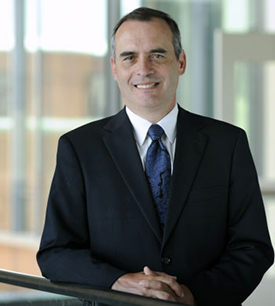
Kevin Knobloch was the Chief of Staff to former Department of Energy Secretary Ernest Moniz. (Photo: Department of Energy)
KNOBLOCH: I'm really excited about our energy efficiency legacy. What I mean by that, is that over the two Obama terms, we at the Department of Energy who had the authority to develop energy efficiency rules, finalized some 50 rules reaching into every corner of the economy - lighting, electronics of all kinds, heating and cooling, appliances, equipment, from industrial furnaces down to window air conditioning units - and in every instance we sought to work collaboratively with the associated manufacturers. And it's very important to understand, to draw on that expertise and understand their perspective, but it's an extraordinary legacy that will be implemented over the next decade and position U.S. companies, and foreign companies doing business in our market, to be producing some of the cleanest most efficient products in the world.
CURWOOD: Somewhat famously, Secretary Perry, when he was running for President suggested that he would eliminate the Energy Department. How did you feel when you heard that he had gotten the top job at Energy?
KNOBLOCH: Governor Perry, now Secretary Perry really needs to be assessed on his merits and on what he does in the role, not what he has said in the past. He did say at his confirmation hearing that he regrets having called for the elimination of the Department of Energy, that he now does not associate himself with that position because, he said, he had received extensive briefings on the mission and responsibilities of the department and is convinced that it is essential to US economy and US national security. That's a positive, and I think we need to see what he does as secretary.
CURWOOD: Kevin Knobloch is former Chief of Staff to Secretary of Energy Ernie Moniz and currently a Senior Research Associate at the Center for International Environment and Resource Policy at Tuft's University. Thanks so much for taking the time to come by.
KNOBLOCH: Steve, it's always a privilege to come talk to you. I really appreciate it.
Related links:
- EnergyWire: “Trump proposes slashing DOE clean energy research”
- The Department of Energy homepage
- Nuclear Regulatory Commission website
- Rick Perry’s confirmation hearing
- Kevin Knobloch DOE Profile
[MUSIC: DAN ZANES, WILD MOUNTAIN THYME, ON NIGHT TIME! 2002, FESTIVAL FIVE RECORDS]
Lessons From Mexico About the Deepwater Horizon Disaster
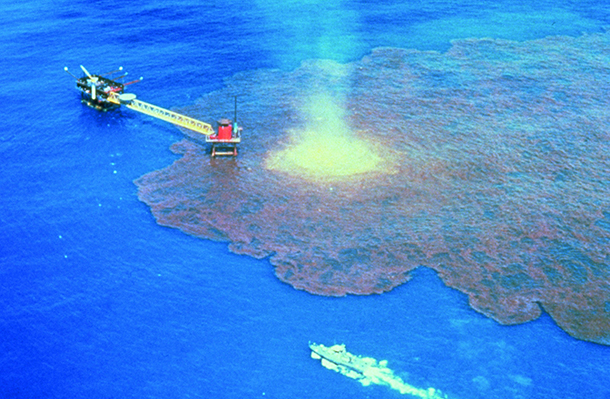
The Ixtoc blowout (Photo: Collection of Doug Helton, NOAA/NOS/ORR, Flickr CC BY 2.0)
CURWOOD: Nearly seven years ago the Deepwater Horizon blowout fouled the Gulf of Mexico with about five million barrels of oil. There are still traces of oil on beaches and on the seabed, and the long-term effects are hard to predict. But scientists for C-IMAGE, the Center for Integrated Modeling and Analyis of the Gulf Ecosystem, are getting a glimpse of what’s to come by studying another major oil spill. This one happened 35 years ago, off the coast of the Yucatan peninsula, and it’s giving researchers a window into the future of the Gulf. David Levin has our story.
[TRAFFIC AND STREET SOUNDS IN CUIDAD DEL CARMEN]
LEVIN: It’s late afternoon in Mexico’s Ciudad del Carmen, and rush hour’s already started. Thick traffic like this is sort of a new thing here. For most of its history, Carmen was just a sleepy fishing town. But that was before the 1970s, when the Mexican government found oil nearby. Over the last four decades, oil has transformed Carmen into a city of more than 160 thousand people. But that growth started with trouble.
News Report 1: A burning offshore oil well is dumping 30,000 barrels of crude each day into the Gulf...
News Report 2: There is now a distinct possibility that oil spilling from that runaway Mexican well could spread as far as the Gulf coast of Florida, that from an official of the EPA...
LEVIN: In June, 1979, just 15 miles offshore from Carmen, a well platform called Ixtoc 1 blew out in 150 feet of water. It caused one of the biggest spills ever to hit the Gulf, and for more than nine months, crews couldn’t plug the leak. The resulting oil slick stretched for hundreds of miles, washing up on beaches from the Yucatan to Texas.
FARRINGTON: I believe my exclamation at the time was “what an unholy mess”.
LEVIN: John Farrington is the Dean Emeritus at the Woods Hole Oceanographic Institution. When oil started coming ashore, the US government sent him and a team of researchers to study the source of the spill. They spent the next two weeks gathering samples off the coast of Ciudad del Carmen.
FARRINGTON: There was a lot of oil going into the water, that’s pretty clear, a lot of oil and gas, so we had an idea that this was very large spill, there was no doubt about it. We didn’t have any good sense of what the impact was on the shoreline other than the oil and tar coming ashore on the coast of Texas.

Because the Deepwater Horizon well is at the bottom of a marine canyon, some effects on its underwater landscape could be comparable to those of the spill at the Ixtoc well, which was perched on the edge of a marine canyon. (Photo: NOAA Office of Coast Survey)
LEVIN: The U.S. team wanted to measure that impact. They wanted to know how the oil was affecting marine life and how fast it would degrade. But before they could finish their cruise, a series of powerful storms crashed into the Texas coast. It washed the oil right off the beaches and cut the team’s work short.
TUNNELL: To the unaided eye, someone could go out there and say, “Well, all the oil is gone.”
LEVIN: Wes Tunnell is a marine biologist at the Harte Research Institute. He was part of the team studying Ixtoc in 1979.
TUNNELL: So word got around that the storms had cleaned the beaches and that currents had reversed and sent oil back to Mexico. And so the funding for all our research basically ended when that word got back to Washington.
LEVIN: Again, John Farrington.
FARRINGTON: A lot more could have been learned, but was not learned, because of a decision made, that it was a Mexican spill, and that was the end of it.
LEVIN: So, Farrington’s team packed up and sailed back to U.S. waters, and American involvement in the spill stopped. A few Mexican teams made sporadic studies over the next few years, but their reports haven’t been widely available outside the country. And Ixtoc more or less faded into memory. Until 2010.
News clip #1: 126 workers were doing routine drilling on the oil platform before it was engulfed by smoke and flames.
News clip #2: “I woke up and then I heard an explosion. I just heard a loud boom.”
News clip #3: It was the first in a series of explosions that set the rig aflame, claiming 11 lives...
LEVIN: Thirty one years after Ixtoc, the Deepwater Horizon blowout dumped millions of barrels of oil into the northern Gulf. The spill lasted almost four months. And although it was slightly larger than Ixtoc, the two disasters were eerily similar. Both were underwater blowouts. Both happened just offshore. And both left huge amounts of oil in the water. Even the shape of the ocean floor below each site is sort of the same.
MURAWSKI: The Ixtoc site is perched on the edge of a marine canyon, like Deepwater Horizon is. Deepwater Horizon was at the bottom of a marine canyon.
LEVIN: Steve Murawski is one of the lead scientists for C-IMAGE, an international team of researchers studying the effects of Deepwater Horizon. He says all the research on the recent spill is only telling scientists how oil is affecting the environment right now. It’s way harder to predict what the impact will be in the future. But since Ixtoc’s so similar, and it happened 35 years ago, he thinks returning to the Mexican site now could tell scientists what to expect near the Deepwater Horizon in the years ahead.
Wes Tunnel joined Murawski’s team to finish the work he started in the 70s. He says that studying Ixtoc today is like stepping into a time machine.
TUNNELL: So it was kind of a “back to the future” kind of thinking. Could we go down there and find any remnants of oil or beyond that, any effect or impact to the environment that might be used to look at the Deepwater Horizon spill and think forward then 30 years.

A heavy band of crude oil from the Deepwater Horizon disaster, May 12th 2010. (Photo: Deepwater Horizon Response Image Gallery, NOAA)
LEVIN: Right now the C-Image team is planning a series of research cruises near the Ixtoc well. They’re using both American and Mexican ships, and for the first time in three decades they’ll be collaborating with Mexican scientists. Together, the international teams will study marine life and sediments on the ocean floor, looking to see whether the ecosystem has bounced back, and, if so, how.
MURAWSKI: When we envisioned this, we envisioned it as a true partnership.
LEVIN: Again, Steve Murawski.
MURAWSKI: Clearly the oceanography and animals in the Gulf of Mexico don’t respect indicidual boundaries between the United States and Mexico. These are political boundaries, not real boundaries, so we should take advantage of the opportunity to create a “one gulf” look at the ecosystem.
LEVIN: It’s a goal that Joel Ortega-Ortiz supports. He trained as a marine biologist in Mexico, and spent time in Ciudad del Carmen as a grad student. Today, he works closely with Murawski at the University of South Florida.
ORTEGA-ORTIZ: The Gulf of Mexico is a shared basin. It’s a large marine ecosystem, and I think everybody understands that the more comprehensive studies that we can do, which obviously will require collaboration, the better that we’ll be able to understand the ecosystem of the Gulf of Mexico.
LEVIN: Ortega-Ortiz grew up seeing the effects of the spill, but he also grew up with the economic bonanza all that oil caused in southern Mexico. He thinks looking at the aftermath of oil spills is an essential way to understand an old and delicate balance in the Gulf. Oil wells like Ixtoc or Deepwater Horizon can inject money into coastal communities, but that same oil can also devastate fisheries and destroy key parts of the ecosystem.
ORTEGA-ORTIZ: We benefit from natural resources, but the use that we make of them comes with risks. I think we will be able to get a more objective image of what’s going on in the environment after this accident and learn so we are better prepared for next one. And there will be next one.
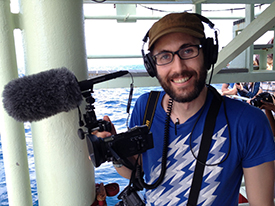
Reporter David Levin at work. (Photo: David Levin)
LEVIN: Today, the C-IMAGE team and their Mexican counterparts are combing through the samples they took at sea, and have started to analyze them in the lab. They’ve already seen some similarities to Deepwater Horizon. Sediment cores taken at Ixtoc show a thick layer of oil and mud that sank to the bottom during that spill, killing off tiny animals low on the food chain. At the time, it wasn’t a pretty picture. But just above those layers, fresh mud slowly starts to reappear, and new within seven years, so do new animals. A decade after the spill, the ecosystem seemed to be back to normal. And that’s a lesson that has Murawski hopeful for the area around Deepwater Horizon. The Gulf’s past, it seems, has a lot to say about its future.
LEVIN: For Living on Earth, I’m David Levin.
Related links:
- Ixtoc I Oil Well
- NOAA Office of Response and Restoration: Deepwater Horizon Oil Spill
- The C-IMAGE website
- David Levin’s production company, Mind Open Media
[MUSIC: Johnny Flynn “THE Box” on A Larum, 2008 MERCURY RECORDS]
CURWOOD: Living on Earth is produced by the World Media Foundation. Our crew includes Naomi Arenberg, Bobby Bascomb, Savannah Christiansen, Jenni Doering, Noble Ingram, Jaime Kaiser, Don Lyman, Alex Metzger, Kit Norton, Helen Palmer, Adelaide Chen, and Jolanda Omari. Tom Tiger engineered our show, with help from John Jessoe and Jake Rego. Alison Lirish Dean composed our themes. You can hear us anytime at LOE.org – and like us, please, on our Facebook page – it’s PRI’s Living on Earth. And we tweet from @LivingOnEarth. I'm Steve Curwood. Thanks for listening.
ANNOUNCER: Funding for Living on Earth comes from you, our listeners, and from the University of Massachusetts, Boston, in association with its School for the Environment, developing the next generation of environmental leaders. And from the Grantham Foundation for the protection of the environment, supporting strategic communications and collaboration in solving the world’s most pressing environmental problems. Support also comes from the Energy Foundation, serving the public interest by helping to build a strong, clean, energy economy, from Carl and Judy Ferenbach of Boston, Massachusetts and from SolarCity, America’s solar power provider. SolarCity is dedicated to revolutionizing the way energy is delivered by giving customers a renewable alternative to fossil fuels. Information at 888-997-1703. That’s 888-997-1703.
ANNOUNCER 2: PRI. Public Radio International.
Living on Earth wants to hear from you!
Living on Earth
62 Calef Highway, Suite 212
Lee, NH 03861
Telephone: 617-287-4121
E-mail: comments@loe.org
Newsletter [Click here]
Donate to Living on Earth!
Living on Earth is an independent media program and relies entirely on contributions from listeners and institutions supporting public service. Please donate now to preserve an independent environmental voice.
NewsletterLiving on Earth offers a weekly delivery of the show's rundown to your mailbox. Sign up for our newsletter today!
 Sailors For The Sea: Be the change you want to sea.
Sailors For The Sea: Be the change you want to sea.
 The Grantham Foundation for the Protection of the Environment: Committed to protecting and improving the health of the global environment.
The Grantham Foundation for the Protection of the Environment: Committed to protecting and improving the health of the global environment.
 Contribute to Living on Earth and receive, as our gift to you, an archival print of one of Mark Seth Lender's extraordinary wildlife photographs. Follow the link to see Mark's current collection of photographs.
Contribute to Living on Earth and receive, as our gift to you, an archival print of one of Mark Seth Lender's extraordinary wildlife photographs. Follow the link to see Mark's current collection of photographs.
 Buy a signed copy of Mark Seth Lender's book Smeagull the Seagull & support Living on Earth
Buy a signed copy of Mark Seth Lender's book Smeagull the Seagull & support Living on Earth

